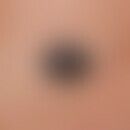Synonym(s)
DefinitionThis section has been translated automatically.
A chronic spirochete infection caused by Treponema pertenue, native to the tropics, related to syphilis but not transmitted venereally. Leads to severe destruction of skin, soft tissues and bones in the final stage. Frambrosis can also be observed in animals (non-human primates - Mubemba B et al. 2019).
PathogenThis section has been translated automatically.
Treponema pertenue (see below Spirochetes). Transmission by intimate contact via fingers, insects, pets, clothing, inhalation, ingestion. Infection usually in childhood.
Phylo-genomic, pan-genomic, core-genomic and singleton analyses reveal the close association between all strains of T. pallidum. Based on genome plasticity analysis, differences in the presence/absence of pathogenicity islands (PAIs) and genomic islands (GIs) can be detected on a subsp. basis. Some genes related to lipid and amino acid biosynthesis are found to be present only in the subsp. of T. pallidum, compared to T. pallidum subsp. endemicum and T. pallidum subsp. pertenue.
The subspecies T. pallidum subsp. endemicum and T. pallidum subsp. pertenu are so similar that they cannot be distinguished serologically. They are antigenically cross-reactive (Jaiswal AK et al. 2020). Their morphology is also indistinguishable. In the 1980s, very limited genetic diversity was found among these pathogen species. Later, it was demonstrated that the genomes of syphilis, yaws and bejel treponemes have an overall similarity of 97-100% and the molecular organization is also identical. This evidence suggests that only small genetic changes in key genes between these organisms are responsible for the reported differences in disease pathogenesis. When looking at the genes in PAIs and GIs, it is noticeable that there are no pathogenicity islands in any of the subspecies. Genes present in pathogenicity islands (PAIs) or genomic islands (GIs) of subspecies pallidum are absent in subspecies endemicum and pertenue (Jaiswal AK et al. 2020).
You might also be interested in
Occurrence/EpidemiologyThis section has been translated automatically.
LocalizationThis section has been translated automatically.
Clinical featuresThis section has been translated automatically.
- Primary Stage: Mother yaws: Inflammatory infiltrated, rapidly ulcerating papules, regional, hard, painless swelling of lymph nodes.
- Secondary stage (3-12 months after infection): Occurrence of daughter yaws (pianomata): Papular, papillomatous, granulomatous, characteristic raspberry-like skin growths. Bone involvement, periosteum involvement. Keratoderma on palms and soles of feet with rhagade formation, scaling and pain, resulting in peculiar gait (crab yaws). Clavi on soles of feet, paronychia.
- Tertiary stage (usually several years after infection): appearance of pianidae: nodular and tuberculoid lesions. Gummata: solitary, hard, later caked, painful, deep subcutaneous nodules, ulcerations. Palmoplantar keratoderma. Osteoarticular lesions: periostitis, osteitis, gummy osteoperiostitis, possibly sabre vaginal tibia. S.a.u. Gangosa; s.a.u. Goundou; s.a.u. juxtaarticular nodules.
DiagnosisThis section has been translated automatically.
Differential diagnosisThis section has been translated automatically.
External therapyThis section has been translated automatically.
Internal therapyThis section has been translated automatically.
Penicillin is the antibiotic of first choice.
- Primary and secondary stage: The single i.m. injection of 2.4 mio. injection of 2.4 million IU (1.2 million IU for children) of benzathine-benzyl penicillin usually leads to healing within a week.
- Tertiary stage: Benzylpenicillin (e.g. Penicillin Grünenthal) 1-5 million IU/day until a total of 15-20 doses are reached.
Alternatively in case of penicillin allergy: tetracycline (e.g. achromycin) 2 g/day for 2 weeks.
Alternative: Azithromycin as a single-shot dose (Maxfield L et al. 2021).
LiteratureThis section has been translated automatically.
- Centurion-Lara A et al. (2006) Molecular differentiation of Treponema pallidum subspecies. J Clin Microbiol 44:3377-3780.
- Giacani L et al (2014) . The endemic treponematoses. Clin Microbiol Rev 27:89-115.
- Jaiswal Arun Kumar et al. (2020) The pan-genome of Treponema pallidum reveals differences in genome plasticity between subspecies related to venereal and non-venereal syphilis BMC Genomics 21: 33.
- Maxfield L et al (2021) Yaws. In: StatPearls. Treasure Island (FL): StatPearls Publishing; PMID: 30252269.
- Mubemba B et al. (2019) Geographically structured genomic diversity of non-human primate-infecting Treponema pallidum subsp. pertenue. Microb Genome 6(11):mgen000463.
- Nyatsanza F et al (2016) Syphilis: presentations in general medicine. Clin Med (Lond) 16:184-188.
- Mitja O et al (2013) Advances in the diagnosis of endemic treponematoses: yaws, bejel, and pinta. PLoS Negl Trop Dis 7:e2283.
- Radolf JD et al (2016) Treponema pallidum, the syphilis spirochete: making a living as a stealth pathogen. Nat Rev Microbiol 14:744-759.
- Zoni AC et al. (2019) Epidemiological situation of yaws in the Americas: A systematic review in the context of a regional elimination goal. PLoS Negl Trop Dis 25;13(2):e0007125.
Incoming links (21)
Bejel; Bouba; Chromomycosis; Crabs; Gangosa; Goundou; Juxtaarticular nodes; Njovera; Old world cutaneous leishmaniasis ; Parangi; ... Show allOutgoing links (18)
Azithromycin; Blastomycosis south american; Chromomycosis; Cutaneous tuberculosis (overview); Early syphilis; Gangosa; Goundou; Juxtaarticular nodes; Leishmaniasis (overview); Leprosy (overview); ... Show allDisclaimer
Please ask your physician for a reliable diagnosis. This website is only meant as a reference.




